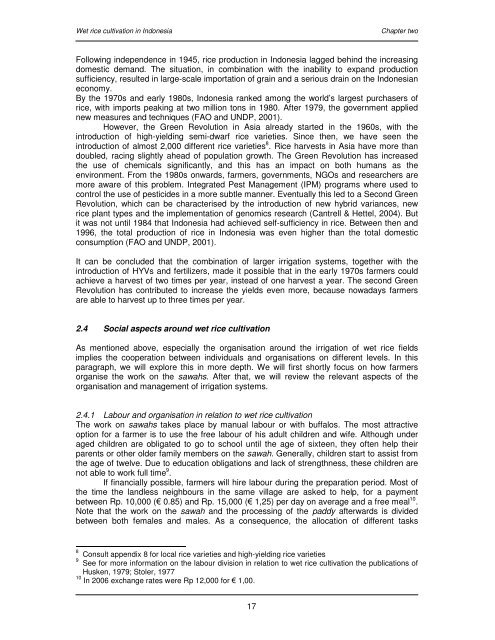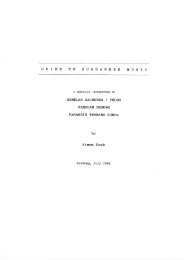Wet rice cultivation in Indonesia - Free EBooks Library
Wet rice cultivation in Indonesia - Free EBooks Library
Wet rice cultivation in Indonesia - Free EBooks Library
You also want an ePaper? Increase the reach of your titles
YUMPU automatically turns print PDFs into web optimized ePapers that Google loves.
<strong>Wet</strong> <strong>rice</strong> <strong>cultivation</strong> <strong>in</strong> <strong>Indonesia</strong> Chapter two<br />
Follow<strong>in</strong>g <strong>in</strong>dependence <strong>in</strong> 1945, <strong>rice</strong> production <strong>in</strong> <strong>Indonesia</strong> lagged beh<strong>in</strong>d the <strong>in</strong>creas<strong>in</strong>g<br />
domestic demand. The situation, <strong>in</strong> comb<strong>in</strong>ation with the <strong>in</strong>ability to expand production<br />
sufficiency, resulted <strong>in</strong> large-scale importation of gra<strong>in</strong> and a serious dra<strong>in</strong> on the <strong>Indonesia</strong>n<br />
economy.<br />
By the 1970s and early 1980s, <strong>Indonesia</strong> ranked among the world’s largest purchasers of<br />
<strong>rice</strong>, with imports peak<strong>in</strong>g at two million tons <strong>in</strong> 1980. After 1979, the government applied<br />
new measures and techniques (FAO and UNDP, 2001).<br />
However, the Green Revolution <strong>in</strong> Asia already started <strong>in</strong> the 1960s, with the<br />
<strong>in</strong>troduction of high-yield<strong>in</strong>g semi-dwarf <strong>rice</strong> varieties. S<strong>in</strong>ce then, we have seen the<br />
<strong>in</strong>troduction of almost 2,000 different <strong>rice</strong> varieties 8 . Rice harvests <strong>in</strong> Asia have more than<br />
doubled, rac<strong>in</strong>g slightly ahead of population growth. The Green Revolution has <strong>in</strong>creased<br />
the use of chemicals significantly, and this has an impact on both humans as the<br />
environment. From the 1980s onwards, farmers, governments, NGOs and researchers are<br />
more aware of this problem. Integrated Pest Management (IPM) programs where used to<br />
control the use of pesticides <strong>in</strong> a more subtle manner. Eventually this led to a Second Green<br />
Revolution, which can be characterised by the <strong>in</strong>troduction of new hybrid variances, new<br />
<strong>rice</strong> plant types and the implementation of genomics research (Cantrell & Hettel, 2004). But<br />
it was not until 1984 that <strong>Indonesia</strong> had achieved self-sufficiency <strong>in</strong> <strong>rice</strong>. Between then and<br />
1996, the total production of <strong>rice</strong> <strong>in</strong> <strong>Indonesia</strong> was even higher than the total domestic<br />
consumption (FAO and UNDP, 2001).<br />
It can be concluded that the comb<strong>in</strong>ation of larger irrigation systems, together with the<br />
<strong>in</strong>troduction of HYVs and fertilizers, made it possible that <strong>in</strong> the early 1970s farmers could<br />
achieve a harvest of two times per year, <strong>in</strong>stead of one harvest a year. The second Green<br />
Revolution has contributed to <strong>in</strong>crease the yields even more, because nowadays farmers<br />
are able to harvest up to three times per year.<br />
2.4 Social aspects around wet <strong>rice</strong> <strong>cultivation</strong><br />
As mentioned above, especially the organisation around the irrigation of wet <strong>rice</strong> fields<br />
implies the cooperation between <strong>in</strong>dividuals and organisations on different levels. In this<br />
paragraph, we will explore this <strong>in</strong> more depth. We will first shortly focus on how farmers<br />
organise the work on the sawahs. After that, we will review the relevant aspects of the<br />
organisation and management of irrigation systems.<br />
2.4.1 Labour and organisation <strong>in</strong> relation to wet <strong>rice</strong> <strong>cultivation</strong><br />
The work on sawahs takes place by manual labour or with buffalos. The most attractive<br />
option for a farmer is to use the free labour of his adult children and wife. Although under<br />
aged children are obligated to go to school until the age of sixteen, they often help their<br />
parents or other older family members on the sawah. Generally, children start to assist from<br />
the age of twelve. Due to education obligations and lack of strengthness, these children are<br />
not able to work full time 9 .<br />
If f<strong>in</strong>ancially possible, farmers will hire labour dur<strong>in</strong>g the preparation period. Most of<br />
the time the landless neighbours <strong>in</strong> the same village are asked to help, for a payment<br />
between Rp. 10,000 (€ 0.85) and Rp. 15,000 (€ 1,25) per day on average and a free meal 10 .<br />
Note that the work on the sawah and the process<strong>in</strong>g of the paddy afterwards is divided<br />
between both females and males. As a consequence, the allocation of different tasks<br />
8<br />
Consult appendix 8 for local <strong>rice</strong> varieties and high-yield<strong>in</strong>g <strong>rice</strong> varieties<br />
9<br />
See for more <strong>in</strong>formation on the labour division <strong>in</strong> relation to wet <strong>rice</strong> <strong>cultivation</strong> the publications of<br />
Husken, 1979; Stoler, 1977<br />
10<br />
In 2006 exchange rates were Rp 12,000 for € 1,00.<br />
17








